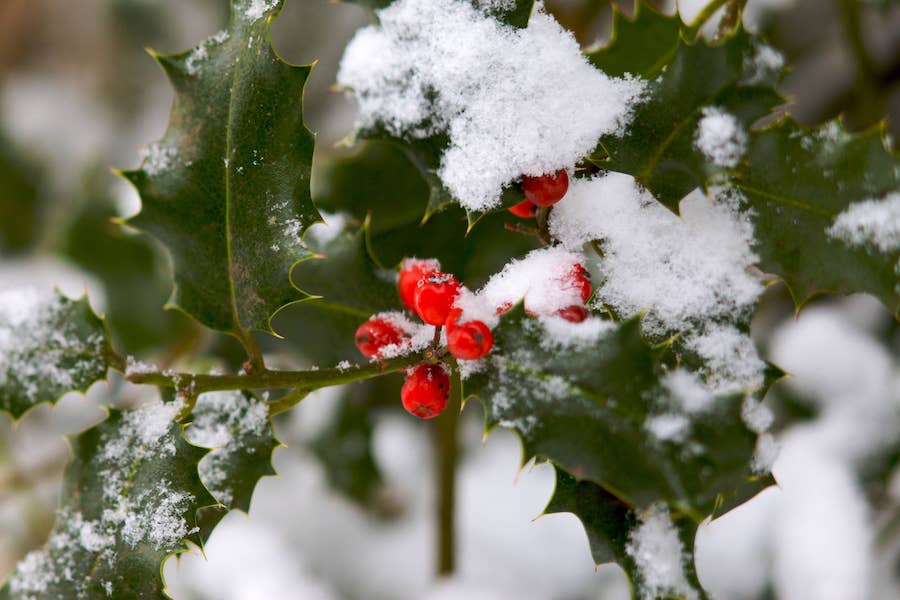9 things you didn’t know about holly, our favourite Christmas plant
There’s more to this festive bush than meets the eye
As Christmas carols top our playlist and The Holly and the Ivy rings out, chances are these thorny leaves and bright red berries are framing your wreath – and lining your favourite winter walk with their decorative foliage.
Not to mention a branch or two at the ready to decorate the Christmas cake and plate of mince pies.
View this post on Instagram
But there’s more to discover about this member of the Aquifoliaceae family and dioecious (there are male and female plants) evergreen tree…
1. Holly is the hero plant to celebrate winter solstice

Stonehenge is a mecca for marking the shortest day of the year
According to legend and pagan rituals, the holly bush symbolises the changing of the seasons, with its evergreen leaves a mark of hope and countdown to Christmas. On the shortest day and longest night of the year (December 22), holly is at the heart of mid-winter festivals.
2. Once planted, they take years to mature

Some holly trees are as old as the hills
The shrub’s latin name is Ilex, meaning evergreen oak and can take up to 20 to 25 years to reach its full size. The result of your painstaking patience will reward you with a thing of beauty… from a baby bush with glossy leaves to a trouble-free, 15m tower which can live for 300 years.
3. You need a ‘his’ and ‘hers’ to grow berries
With grand names such as Golden King and Golden Queen, you could be forgiven for thinking the King is a ‘he’ and Queen a ‘she.’ Ironically, it’s the other way round and they need to be planted close to each other to bear berries.
4. They’re worth their weight in gold

Holly flowers in summer are white with four petals
Holly’s versatility makes it an ideal tree or shrub that’s easy to grow. Whether it’s sun or partial shade, they love a lawn; they’re ornamental and can be pruned into pyramid shapes; their shiny, evergreen foliage provides colour all year-round; they require minimal pruning if left undisturbed; they give the gift of white flowers in summer.
5. Holly leaves can act as mini lightning rod
Back in the day…thanks to spines on their characteristic shaped leaves acting as miniature lightning conductors, holly trees were planted near houses to help guard against threatening strikes.
6. The berries are toxic to humans and animals, bar birds

Holly berries are a vital source of winter food for birds
While the compounds in berries are poisonous to people and pets, birds such as blackbirds, thrushes and redwings can eat them in small quantities during cold winter months when the berries are less bitter.
7. Holly’s known for safeguarding against evil spirits
According to folklore, holly wards off evil and witches. It was considered bad luck to cut down a whole tree and trim bushes. A symbol of hope, Harry Potter’s wand is made of holly to help him on his mystical quest, and why pagan druids wore holly in their hair.
8. Hedgehogs love holly

Hedgehogs like to cosy up and shelter under the holly
Wildlife, especially hedgehogs, call a holly bush home when they hibernate in winter. Their dense branches are beloved by birds for nesting, and deer feed on their smooth, upper leaves in winter.
9. Some species of holly are a source for herbal tea
There are around 600 genus worldwide, and some shrubs and trees native to South America make yerba mate, guayusa, and yaupon teas. Prized for their energising and healing powers, these ‘caffeinated hollies,’ may be as stirring as a beautiful holly wreath bursting with crimson berries.
The Press Association
Latest posts by The Press Association (see all)
- The best ways to boost your immune system as cold temperatures hit - January 5, 2025
- The Osmonds star and ‘beloved husband and father’ Wayne Osmond dies aged 73 - January 2, 2025
- What screenings are available on the NHS to detect cancer early? - January 2, 2025
- Help your grandchildren make the most of Big Schools’ Birdwatch - January 1, 2025
- Veteran radio star Johnnie Walker dies aged 79 - December 31, 2024




















